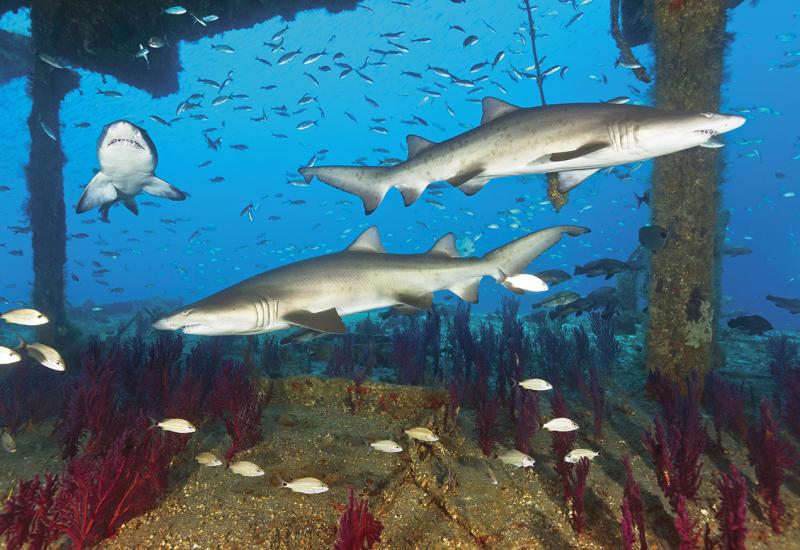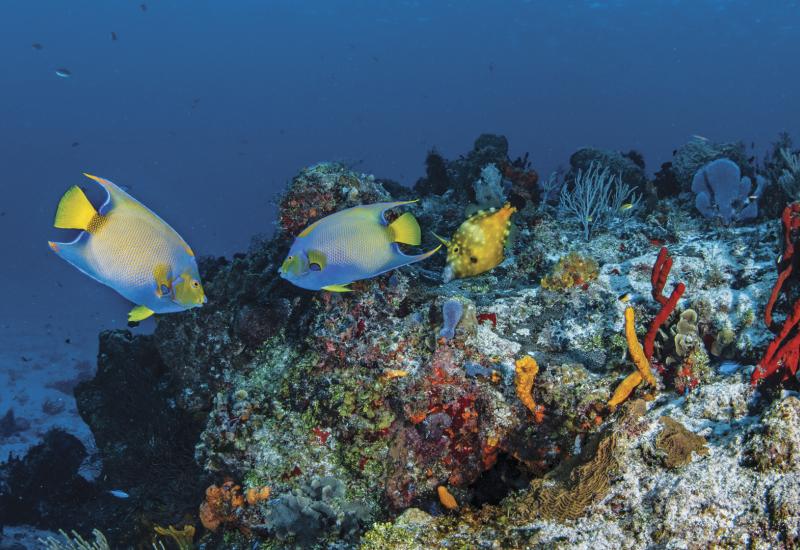North Carolina
Up top it's the present day, and the Outrageous V flagship of PADI 5-Star IDC Discovery Diving Company's fleet is bobbing in the sunshine off North Carolina's Cape Lookout Shoals. But down where I am, 115 feet deep, it's World War II. Time-ravaged and listing heavily on her white-sand resting-place, the German submarine U-352 is a trigger to the senses. Just looking at her, I can almost hear the depth charges and deck-gun fire that sent her here. I can only too easily imagine her sailors scrambling to escape flooding compartments and the urgency with which they tried to coax her surfaceward. She is slowly being reclaimed by the sea, but her pressure-hull remains, and if you swim past the stern and look carefully, you can see the diesel fuel "dripping" upward toward the surface, as it has done every day since May 9, 1942.
I arrive at the open forward-torpedo-loading hatch, check my gauges, switch on my primary light, and glide in, making a 120-degree turn to the rear just as soon as my fins have cleared the opening. Switching from reef-diver mode to wreck-diver mode, I keep my feet still and well off the light silt that sleeps uneasily beneath me. When I move, I do so by gently pulling my way back with my fingertips.
I do not go too far. Submarines are usually simple wrecks to navigate, with a central passageway running virtually from stem to stern. But I have an experienced wreck-diving friend who once got silted-out in this very spot and took better than twenty minutes to find his way out. Besides, even here in the semi-gloom, I can vividly picture what it must have been like to be tossed from bulkhead to bulkhead as the battle-lights failed and seawater sprayed from ballast lines. So I simply hover and absorb it all. Then I turn and, gliding as silently as the wraiths that I can imagine traveling stealthily beside me, make my way out.
The U-352 went down with little fanfare. She got no headlines, and the sailors who sunk her were sworn to secrecy because the battle that sealed her fate did not take place hundreds of miles out in the open ocean. She was sunk off the Outer Banks of North Carolina not very far from the lights marking Beaufort Inlet and the wartime government wanted her sinking kept a secret because it could have demoralized wartime Americans if they had realized just how close to the coast the Nazi submarines were plying their deadly trade.
The nickname for this area is "The Graveyard of the Atlantic," and, in one way, that appellation is entirely appropriate. North Carolina and her barrier islands The Outer Banks form a knuckle on the eastern seaboard, an area where freighters plying the New York-to-Miami corridor have always run near to shore. Outlined by the lights of villages and towns, this coastal shipping lane became a virtual shooting gallery for U-boats lying in wait in the night. Throughout both World War I and World War II, hundreds of freighters were torpedoed and sent to the bottom, joining the scores that had already met their fates in Outer Banks storms and strandings. In all, more than 650 ships perished off the Banks between 1526 and 1945.
They include North Carolina classics such as the petroleum tanker Papoose, torpedoed by the U-124 on March 18, 1942. Now lying 120 feet deep, this wreck is a veritable magnet for sand tiger sharks, as are several other neighboring wrecks, most notably the Caribsea. Dive any of these in January and February when the sharks are mating, and you can literally scoop sharks' teeth off the bottom by the handful. Come back in mid-summer, and the rusting hulls will be crowded with grouper and tropical fish typically seen several hundreds of miles further south.
The W.E. Hutton, sunk by the U-124 on the same night as the Papoose, came to rest in shallower water and, almost exactly one year later, caused the 338-foot freighter Suloide to founder when she struck its remains. Both wrecks were demolished as menaces to navigation and are now strewn over the bottom in 60 to 70 feet of water.
Scores of other merchant ships met similar fates, but not all the ships off the Outer Banks sank on the bitter end of a torpedo. The U.S.S. Schurz is known as the "World War I Wreck," but it did not go down as the result of an act of war; the 295-foot cruiser was accidentally rammed by a tanker in 1918. The American submarine Tarpon was lost while being towed to the scrapyard in 1957, giving her a much more noble end than that for which she'd been intended. And some of the ships on the bottom off the Outer Banks were deliberately placed there; the 426-foot Navy cable-layer Aeolus is currently in four pieces, not because of martial mayhem, but because storm surge from Hurricane Fran was able to reach this artificial-reef project in 120 feet of water.
Diving North Carolina's Outer Banks is most comfortably done with a heavy wetsuit or a dry suit during the winter months. But in summer, when the Gulf Steam's tropical water moves inshore, some old-school divers explore the Graveyard's shipwrecks wearing only mechanic's coveralls for scrape protection.
The Outer Banks and the Graveyard of the Atlantic are a Carolina treasure, and many local divers see little reason to leave their own backyard to find a lifetime of underwater adventure. Fortunately, they like to share. Thousands of visitors flock in every year to sample North Carolina's diving as well as its other charms, such as low-country barbecue, beach music, and shore attractions that include one of the world's greatest saltwater aquariums.










